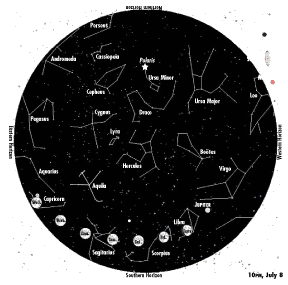 |
Sky Watch
by J. Alex Knoll
|
The Fiery Red Scorpion’s Heart
This royal star shines through the night
The moon waxes through evening skies this week until the witching hour between Monday and Tuesday, when the full, Thunder Moon shines from dusk to dawn. Other names for July’s full moon include the Blood Moon, the Red Cherry Moon, the Full Hay Moon and the Buck Moon, marking the time when the new antlers of male deer sprout in coatings of velvet-like fur. Early Europeans called this the Mead Moon, and we also know it as the Rose Moon and the Mid-Summer Moon.
Friday evening the moon is barely three degrees from Antares, the red supergiant marking the heart of Scorpius. Meaning “rival of Ares” and called the “rival of Mars,” this star actually outshines the red planet, which sets in the west just after darkness as Antares appears in the south.
With its long tail, Scorpius is one of the few constellations that looks like its name. Once the scorpion had claws, but Julius Caesar reworked the constellation, adding them to the scales of Libra.
The scorpion is well known for its sting that killed the mighty hunter Orion. But the importance of the constellation and its red star are much older. In ancient Sumeria, Mesopatamia and Persia, Antares was revered as the royal star of the west, one of four guardians of the heavens. The other three are Aldebaran, the eastern royal star, in the constellation Taurus; Regulus, the northern royal star, in the constellation Leo; and Fomalhaut, the southern royal star in the constellation Pisces Austrinus, the Southern Fish.
Much cooler than our sun, Antares is the fifteenth brightest star in our sky, appearing so bright because of its immense mass, more than 500 times the size of our sun and second only to Betelgeuse in Orion.